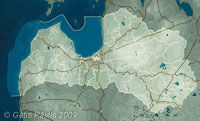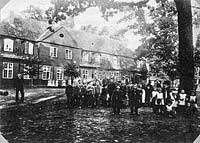
| Coordinates: | 56°59'14,00'' N
24°08'02,38'' E
Google Maps (localisation not exact, possible mistake up to 50 metres) |
| No: | 133 (list of all monuments) |
| Category: | Palaces and manor houses |
| Address: | Riga, Sarkandaugava, area of Duntes, Pededzes and Ozolu Streets |
| Versions of name: | Eichenheim, Ozolaine, Kaminga muiža, Kūmiņa muiža, Kummingshof |
| Year of construction: | 18th c.? |
| Architectural style: | Barocco |
| Condition: | Does not exist |
| Value: | Architecture |
History of this manor started latest in 17th century. It was located in beautiful forest, next to distributary of Daugava - Sarkandaugava, on steep bank.
History
In 17th century in area of Ozolaine there already was Dunte manor - owner in 1630ies was Jürgen Dunte.
In second half of 18th century several land plots were merged by merchant from England Patrick Cumming - thus there was created Cumming manor which served as summer house. In the middle of 19th century James Moris Cumming purchased nearby Budberg manor. Manor house was located at the bank of Sarkandaugava, in square where earlier as located Papavu or Nibur tavern. Latvians at that time called this manor - "Kumiņa dārzs" (Garden of Kumins).
Patrick Cumming with another Englishman F.J.Fenton established a powerful export trade enterprise "Cumming-Fenton & Co". Cummings did not accept status of Russian citizen, they were not part of any guild or local union and worked as foreign company - thus they paid higher taxes. During the Napoleonic war their situation became worse but company continued activites. Patrick Cumming in this time was residing in England.
Since 1872 part of manor belonged to some philanthropy organisation ("society against begging"), it existed here up to First World War. House was adjusted for these needs, there were performed significant transformations. Another part of building with later household buildings was under the supervision of "union of literary practical citizens", here was a school and boarding-school for orphans, shelter for children. Activity of the school ended with the start of Russification policy - but it was considered to be a good school. There was place for swimming in Sarkandaugava in the front of school.
Only in the second half of 19th century manor was called Ozolaine (Eichenheim) - by this time there were grown up the large oak trees in manor park.
Description
Shown in the work of J.C.Brotze (4., p.144.) as a manor next to Sarkandaugava, as well as in map from 1701.
Manor house was built in the second half of 18th century, in Barocco style. Wooden building had two floors with inhabitable French roof and mezzanine. It perished in 1920ies - 1950ies.
J.C.Brotze has drawn it in 1795. Then manor had tiled roof, large windows. There was beautiful view on meadows and pastures at the other side of Sarkandaugava, wonderful forest around the manor house. In the manor park not far from the house there were also some graves, on one grave there was inscription from year 1647 (5.).
Images
References
- Koka Rīga, Rīga, Neputns, 2001, p.94.
- Kaupuža D. Rīgas muižiņas. Latvijas architektūra, Rīga, 2005, p.95.
- Latvijas piļu un muižu asociācijas mājaslapa, visited on 21st June 2009.
- Broce J.K. Zīmējumi un apraksti, 2.sējums, Rīga, Zinātne, 1996, pp.144.,181.,476.
- Ozoliņš K. Sode (Sarkandaugava). Senā Rīga. Pētījumi pilsētas arheoloģijā un vēsturē, Rīga, Latvijas vēstures institūta apgāds, 2003, p.444.
- Enciklopēdija Rīgas ielas, 2.sējums, Rīga, 2008, p.275.
- Situations-Plan der Riga'schen Vorstadte, Riga den 13 Marz, 1879, Steinbach






